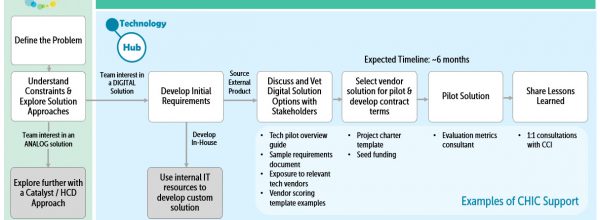We have been building an innovation ecosystem in California for many years.
When we began this work, we had a loose hypothesis for what it would take. We believed to build an ecosystem, it required a few essential elements. We needed to 1) build skills and capabilities among health care providers and leaders, 2) provide a safe space and funding to take risks, 3) leverage shared expertise and resources, and 4) most importantly, create a network of peers and champions who are willing to test innovations, share ideas, and learn together. Our experience has taught us that these elements are essential, and now we have an opportunity to take these lessons to Colorado to build another innovation ecosystem.
Thanks to our partnership with the Colorado Health Foundation, the Denver Foundation, Colorado Access, and a few other funders we are currently finalizing, we have an opportunity to leverage the infrastructure we built in California and analyze what needs to be adapted to enable real change in a new community.
I just read an article in the Stanford Social Innovation Review that does a great job of outlining why cultivating an innovation ecosystem is worth the work. Its lessons definitely resonate with our experiences as well.
1. Identify a shared dream. It has been important for us to project our vision — bringing innovation and new ideas to solve critical health problems for underserved patients. It is something people recognize is an opportunity and traditionally innovation resources have not focused on these high-need populations.
2. Start with motivated champions. We have also learned that for our early innovation work, we need to go to those most willing and able to take risks and are excited to learn with us.
3. Build from small wins. We also learned that we had to show small wins early or else we won’t be able to continue to attract funding, attention, and excitement for this work. It is easy to get stuck in planning, but we recognized that we needed to really move and act quickly to see change.
4. Create safe spaces for joint learning. This has been a critical lesson and something we had to communicate to our funders as well. If we are to encourage risk taking, we must expect that sometimes the projects won’t succeed; but it’s important to have a neutral convener (like us) to be able to help reflect and share what we learned together.
5. Celebrate progress publicly. I think we were slower than we should have been on this front. Yet with encouragement from one of our key funders — the Blue Shield of California Foundation — we started publishing, creating case studies, and communicating in public forums what we are learning. This is a great lesson as we start new work in Colorado.
We’re continuing to learn about what it takes to create change and momentum at a community level. I’m curious to hear how these lessons resonate with you. As we begin a new innovation ecosystem in Colorado and extend the CCI innovation ecosystem beyond California, what else should we be considering?


